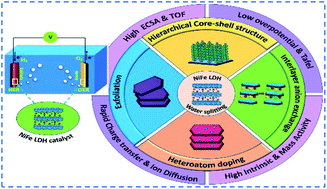Recent advances in highly active nanostructured NiFe LDH catalyst for electrochemical water splitting
Abstract
Highly efficient, low-cost electrocatalysts having superior activity and stability are crucial for practical electrochemical water splitting, which involves hydrogen and oxygen evolution reactions (HER and OER). The sustainable production of hydrogen fuel from electrochemical water splitting requires the development of a highly efficient and stable electrocatalyst with low overpotential that drives electrochemical redox reactions. Electrochemical water splitting using highly active nickel-iron layered double hydroxide (NiFe LDH) catalyst having a very high turnover frequency and mass activity is considered as a potential contender in the area of electrocatalysis owing to the practical challenges including high efficiency and long durability at low overpotential, which shows great potential in future hydrogen economy. This review includes certain recommendations on enhancing the electrocatalytic performance of NiFe LDH-based electrocatalyst, particularly through morphology engineering, construction of hierarchical/core–shell nanostructures, and doping of heteroatoms through combined experimental assessment and theoretical investigations, which in turn improve the electrocatalytic performance. Finally, emphasis is made on the bifunctional activity of the NiFe LDH catalyst for overall water splitting. At the end, the conclusions and future outlook for the design of the NiFe LDH catalyst towards scale-up for their use as electrolyzer at the industrial level are also discussed.

- This article is part of the themed collections: Editor’s Choice 2023: Advancing electrocatalysts for a sustainable future. and Energy Frontiers: Electrochemistry and Electrochemical Engineering


 Please wait while we load your content...
Please wait while we load your content...